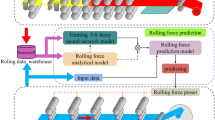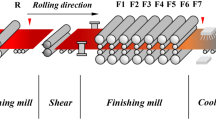Abstract
Aiming to further improving the calculation accuracy of rolling force in the FGC process of tandem cold rolling, the exit thickness accuracy and exit flatness accuracy of the strip in the first few coils after the gauge changing rolling process, a rolling force prediction method based on IQGA-WNN ensemble learning is proposed in this paper in light of the large change of strip parameters and the unstable quality of coils during the FGC process. Firstly, the traditional QGA is improved by quantum variation to avoid falling into local optimal solution. Secondly, the improved QGA is used to optimize the initial parameters of the network to improve the prediction ability of WNN. Finally, the WNNs improved by IQGA are used as the base learners for ensemble learning and are effectively integrated through bagging algorithm to further improve the prediction ability of the model. The rolling force prediction model proposed in this paper is tested on a 1450-mm five-stand tandem cold rolling production line. The results show that, compared with the traditional rolling force model, the separate WNN and IQGA-WNN models, for the first three coils of strip after FGC rolling, the ensemble learning model obtains the minimum rolling force calculation error and strip exit thickness and flatness deviation, the accuracy and stability of the rolling process are improved significantly, which proves the feasibility and effectiveness of the model proposed in this paper.










Similar content being viewed by others
References
Cao JG, Wang T, Cao Y, Song CN, Gao B, Wang B (2021) Cold rolling force model of nuclear power zirconium alloy based on Particle Swarm Optimization. Int J Adv Manuf Tech 115:319–328. https://doi.org/10.1007/s00170-021-07210-3
Wang HH, Ding S, Taylor T, Yanagimoto J (2021) Cold rolling texture prediction using finite element simulation with zooming analysis. Materials 14:6909. https://doi.org/10.3390/ma14226909
Li L, Matsumoto R, Utsunomiya H (2018) Experimental study of roll flattening in cold rolling process. ISIJ Int 58:714–720. https://doi.org/10.2355/isi**ternational.ISIJINT-2017-623
** X, Li CS, Wang Y, Li XG, Gu T, **ang YG (2020) Multi-objective optimization of intermediate roll profile for a 6-high cold rolling mill. Metals-Basel 10:287. https://doi.org/10.3390/met10020287
**e HB, Jiang ZY, Tieu AK, Liu XH, Wang GD (2008) Prediction of rolling force using an adaptive neural network model during cold rolling of thin strip. Int J Mod Phys B 22:5723–5727. https://doi.org/10.1142/S0217979208051078
You GH, Li S, Wang ZG, Yuan R, Wang ML (2020) A novel analytical model based on arc tangent velocity field for prediction of rolling force in strip rolling. Meccanica 55:1453–1462. https://doi.org/10.1007/s11012-020-01178-2
Shatalov RL, Kulikov MA (2020) Influence of outer parts of a strip on the deformation and force parameters of thin-sheet rolling. Metallurgist+ 64:687–698. https://doi.org/10.1007/s11015-020-01045-1
Zhang YF, Zhao MY, Xu L, Di HS, Zhou XJ, Wen P, Zhao DW, Zhang DH (2022) Optimization solution of vertical rolling force using unified yield criterion. Int J Adv Manuf Tech 119:1035–1045. https://doi.org/10.1007/s00170-021-08333-3
Chen LZ, Sun WQ, He AR, Yuan TH, Shi JR, Qiang Y (2022) Research on thickness defect control of strip head based on GA-BP rolling force preset model. Metals-Basel 12:924. https://doi.org/10.3390/met12060924
Yang YB, Peng Y (2020) Dynamic rolling model based on uniform deformation. J Manuf Process 58:1334–1347. https://doi.org/10.1016/j.jmapro.2020.08.065
Liu JY, Liu XX, Ba TL (2019) Rolling force prediction of hot rolling based on GA-MELM. Complexity. 3476521. https://doi.org/10.1155/2019/3476521
Klassen EY, Kolesnikov AG, Cherepanov DS (2018) Analytical dependences for determining specific pressures along the length of the deformation zone in tube cold rolling mills. Metallurgist+ 62:686–693. https://doi.org/10.1007/s11015-018-0709-8
Otsuka T, Sakamoto M, Takamachi Y, Higashida Y, Segawa Y, Takeshima S (2017) An online rolling model for plate mill using parallel computation. ISIJ Int 57:2042–2048. https://doi.org/10.2355/isi**ternational.ISIJINT-2017-299
Li JD, Wang XC, Yang Q, Guo Z, Song LB, Mao X (2022) Rolling force prediction in cold rolling process based on combined method of T-S fuzzy neural network and analytical model. Int J Adv Manuf Tech 121:4087–4098. https://doi.org/10.1007/s00170-022-09567-5
Lee S, Son Y (2021) Motor load balancing with roll force prediction for a cold-rolling setup with neural networks. Mathematics-Basel 9:1367. https://doi.org/10.3390/math9121367
Hwang R, Jo H, Kim KS, Hwang HJ (2020) Hybrid model of mathematical and neural network formulations for rolling force and temperature prediction in hot rolling processes. IEEE Access 8:153123–153133. https://doi.org/10.1109/ACCESS.2020.3016725
Zhang SH, **n JL, Che LZ (2021) Modeling of rolling force for thick plate of multicomponent alloys and its application on thickness prediction. Front Mater 8:741144. https://doi.org/10.3389/fmats.2021.741144
Kozhevnikov AV, Kozhevnikova IA, Bolobanova NL (2017) Simulation of cold-rolling process in dynamic conditions. Metallurgist+ 61:519–522. https://doi.org/10.1007/s11015-017-0526-5
Li LJ, **e HB, Liu TW, Li XS, Liu X, Huo MS, Wang ER, Li JX, Liu HQ, Sun L, Jiang ZY (2022) Effects of rolling force on strip shape during tandem cold rolling using a novel multistand finite element model. Steel Res Int 93:2100359. https://doi.org/10.1002/srin.202100359
Kuo CL, Kuruoglu EE, Chan WKV (2022) Neural network structure optimization by simulated annealing. Entropy-Switz 24:348. https://doi.org/10.3390/e24030348
Liu ZP, Feng R, Li XH, Wang W, Wu XL (2021) Gradient-sensitive optimization for convolutional neural networks. Comput Intel Neurosc 2021:6671830. https://doi.org/10.1155/2021/6671830
O’Reilly J, Pillay N (2022) Supplementary-architecture weight-optimization neural networks. Neural Comput Appl 34:11177–11197. https://doi.org/10.1007/s00521-022-07035-5
Baioletti M, Di Bari G, Milani A, Poggioni V (2020) Differential evolution for neural networks optimization. Mathematics-Basel 8:69. https://doi.org/10.3390/math8010069
Zhang SH, Che LZ, Liu XY (2021) Modelling of deformation resistance with big data and its application in the prediction of rolling force of thick plate. Math Probl Eng 2021:2500636. https://doi.org/10.1155/2021/2500636
Ganaie MA, Hu MH, Malik AK, Tanveer M, Suganthan PN (2022) Ensemble deep learning: A review. Eng Appl Artif Intel. 115:105151. https://doi.org/10.1016/j.engappai.2022.105151
Wang LX, Mao SW, Wilamowski BM, Nelms RM (2020) Ensemble learning for load forecasting. IEEE T Green Commun 4:616–628. https://doi.org/10.1109/TGCN.2020.2987304
Abu Bakar A, Hamdan R, Sani NS (2020) Ensemble learning for multidimensional poverty classification. Sains Malays. 49:447–459. https://doi.org/10.17576/jsm-2020-4902-24
Alqahtani A, Alsubai S, Sha MHM, Vilcekova L, Javed T (2022) Cardiovascular disease detection using ensemble learning. Comput Intel Neurosc 2022:5267498. https://doi.org/10.1155/2022/5267498
Guo YY, Wang X, **ao PC, Xu XZ (2020) An ensemble learning framework for convolutional neural network based on multiple classifiers. Soft Comput 24:3727–3735. https://doi.org/10.1007/s00500-019-04141-w
Yu L, Wu Y, Tang L, Yin H, Lai KK (2021) Investigation of diversity strategies in RVFL network ensemble learning for crude oil price forecasting. Soft Comput 25:3609–3622. https://doi.org/10.1007/s00500-020-05390-w
Alam KMR, Siddique N, Adeli H (2020) A dynamic ensemble learning algorithm for neural networks. Neural Comput Appl 32:675–8690. https://doi.org/10.1007/s00521-019-04359-7
Shoaib M, Shamseldin AY, Khan S, Khan MM, Khan ZM, Sultan T, Melville BW (2018) A comparative study of various hybrid wavelet feedforward neural network models for runoff forecasting. Water Resour Manag 32:83–103. https://doi.org/10.1007/s11269-017-1796-1
Gursoy O, Engin SN (2019) A wavelet neural network approach to predict daily river discharge using meteorological data. Meas Control-Uk 52:599–607. https://doi.org/10.1177/0020294019827972
Liu JW, Zuo FL, Guo YX, Li TY, Chen JM (2021) Research on improved wavelet convolutional wavelet neural networks. Appl Intell 51:4106–4126. https://doi.org/10.1007/s10489-020-02015-5
Deepa SN, Rizwana JB (2018) Momentum-based wavelet and double wavelet neural networks for power system applications. Neural Comput Appl 29:495–511. https://doi.org/10.1007/s00521-016-2552-9
Shi S, Zhang XL, Zhao XL, Yang L, Du W, Wang YJ (2019) Prediction of the RNA secondary structure using a multi-population assisted quantum genetic algorithm. Hum Hered 84:1–8. https://doi.org/10.1159/000501480
Dong YM, Zhang JL (2021) An improved hybrid quantum optimization algorithm for solving nonlinear equations. Quantum Inf Process 20:134. https://doi.org/10.1007/s11128-021-03067-3
Chen BQ, Niu XF (2020) Quantum neural network with improved quantum learning algorithm. Int J Thero Phys 59:1978–1991. https://doi.org/10.1007/s10773-020-04470-9
Tkachuk V (2018) Quantum genetic algorithm based on qutrits and its application. Math Probl Eng 2018:8614073. https://doi.org/10.1155/2018/8614073
SaiToh A, Rahimi R, Nakahara M (2014) A quantum genetic algorithm with quantum crossover and mutation operations. Quantum Inf Process 13:737–755. https://doi.org/10.1007/s11128-013-0686-6
Tan YH, Chen SH, Zhang GM, **ong ZT (2013) Adaptive impedance matching using quantum genetic algorithm. J Cent South Univ 20:977–981. https://doi.org/10.1007/s11771-013-1573-0
Lamata L, Alvarez-Rodriguez U, Martin-Guerrero JD, Sanz M, Solano E (2019) Quantum autoencoders via quantum adders with genetic algorithm. Quantum Sci Technol. 4:014007. https://doi.org/10.1088/2058-9565/aae22b
Ngo G, Beard R, Chandra R (2022) Evolutionary bagging for ensemble learning. Neurocomputing 510:1–14. https://doi.org/10.1016/j.neucom.2022.08.055
Liu XB, Wang GJ, Cai ZH, Zhang H (2016) Bagging based ensemble transfer learning. J Amb Intel Hum Comp 7:29–36. https://doi.org/10.1007/s12652-015-0296-5
Le-Rademacher J, Billard L (2017) Principal component analysis for histogram-valued data. Adv Data Anal Classi 11:327–351. https://doi.org/10.1007/s11634-016-0255-9
Kwon J, Oh HS, Lim Y (2020) Dynamic principal component analysis with missing values. J Appl Stat 47:1957–1969. https://doi.org/10.1080/02664763.2019.1699910
Beattie JR, Esmonde-White FWL (2021) Exploration of principal component analysis: deriving principal component analysis visually using spectra. Appl Spectrosc 75:361–375. https://doi.org/10.1177/0003702820987847
Li LM, Zhao J, Wang CR, Yan CJ (2020) Comprehensive evaluation of robotic global performance based on modified principal component analysis. Int J Adv Robot Syst 17:1729881419896881. https://doi.org/10.1177/1729881419896881
Liu YM, Sun J, Wang QL, Zhang DH, Zhao DW (2017) Mathematical model for cold rolling based on energy method. Meccanica 52:2069–2080. https://doi.org/10.1007/s11012-016-0569-x
Li Y, Jiang Z, Li F (2009) Analysis of rolling force model in cold rolling mill. Rev Metall-Paris 106:69–73. https://doi.org/10.1051/metal/2009016
Wang ZH, Zhang DH, Gong DY, Peng W (2019) A new data-driven roll force and roll torque model based on FEM and hybrid PSO-ELM for hot strip rolling. ISIJ Int 59:1604–1613. https://doi.org/10.2355/isi**ternational.ISIJINT-2018-846
Tieu A, Zhu HT, Lu C, You C, Jiang ZY, D’Alessio G (2006) Modelling of friction coefficient in cold strip rolling. Mater Sci Forum 505–507:1285–1290. https://doi.org/10.4028/www.scientific.net/MSF.505-507.1285
Li WG, Liu C, Feng N, Chen X, Liu XH (2016) Friction estimation and roll force prediction during hot strip rolling. J Iron Steel Res Int 23:1268–1276. https://doi.org/10.1016/S1006-706X(16)30187-X
Acknowledgements
This study was financially supported by Ministry of Industry and Information Technology High-Tech Ship Research Project: Research on Development and Application of Digital Process Design System for Ship Coating (No.: MC-202003-Z01-02) and Innovation Fund General Project of Nan**g Institute of Technology (No.: CKJB202209).
Author information
Authors and Affiliations
Corresponding author
Ethics declarations
Ethics approval
Not applicable.
Consent to participate
The authors declare that they all participated to the work.
Consent for publication
All the authors agree to publish the paper in the International Journal of Advanced Manufacturing Technology.
Competing interests
The authors declare no competing interests.
Additional information
Publisher's note
Springer Nature remains neutral with regard to jurisdictional claims in published maps and institutional affiliations.
Rights and permissions
Springer Nature or its licensor (e.g. a society or other partner) holds exclusive rights to this article under a publishing agreement with the author(s) or other rightsholder(s); author self-archiving of the accepted manuscript version of this article is solely governed by the terms of such publishing agreement and applicable law.
About this article
Cite this article
Yan, Z., Bu, H., Hu, C. et al. Rolling force prediction during FGC process of tandem cold rolling based on IQGA-WNN ensemble learning. Int J Adv Manuf Technol 125, 2869–2884 (2023). https://doi.org/10.1007/s00170-023-10899-z
Received:
Accepted:
Published:
Issue Date:
DOI: https://doi.org/10.1007/s00170-023-10899-z




